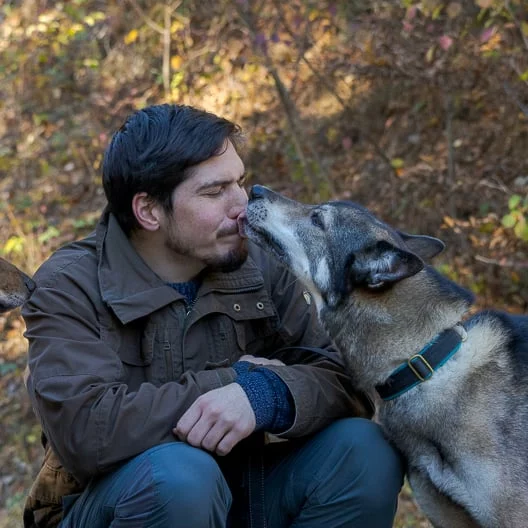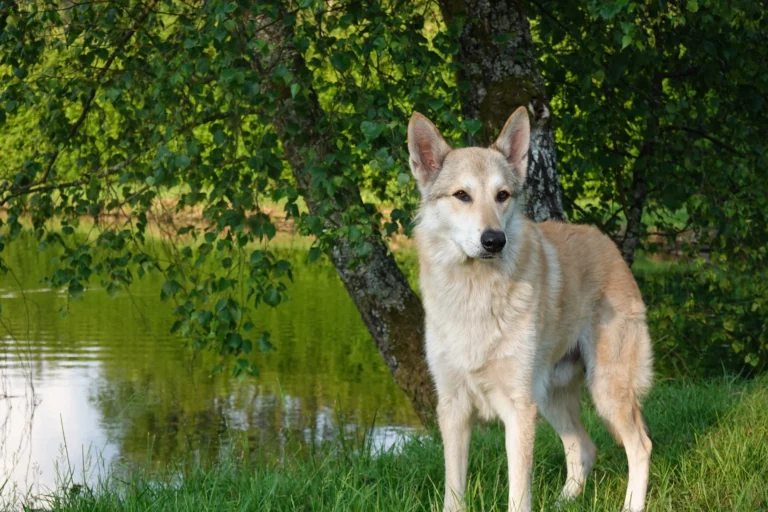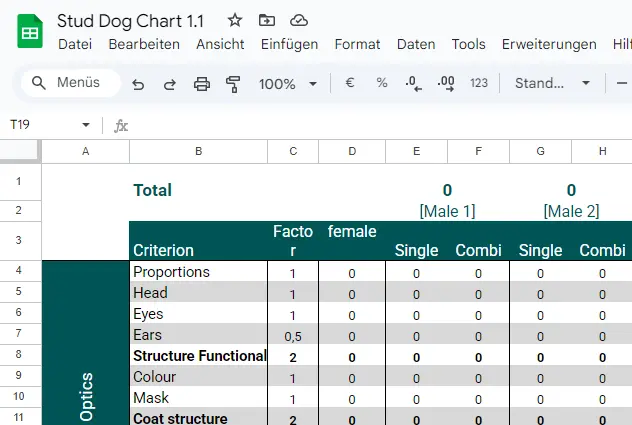
What exactly is the stud dog chart?
The stud dog chart is a tool that members (especially breeders and those who want to become breeders) can use to get an overview in advance of the advantages and disadvantages of combining their own female dog with a potential stud dog. The chart is based on the individual assessment of both dogs and broken down into an easy-to-understand evaluation system, which I would like to explain to you in more detail here.
Für vollständigen Zugriff auf diesen Artikel, benötigst du eine Plus Mitgliedschaft.
Step 1
As usual, you can find the link to the stud dog chart in the members‘ area, at the bottom right of the breeding section (or via this link):

The document itself is created in Google Sheets. You can create a copy of the file here and then edit it yourself. To do this, click on ‘File’ under the title at the top and then on ‘Make a copy’ (or ‘File’ -> ‘make a copy’):
As soon as you do that, you will be asked where on your private Google Drive you want to store the file and the copy will then open by itself.
In the following, I would like to go through each tab in the document individually and provide a brief guide to how to use it. You will find the individual tabs horizontally listed at the bottom of the page:
Quick Overview
As soon as you have the stud dog chart open in front of you, you will be greeted with a short explanation of the functionality on the ‘Start’ tab. The concept here is quite simple: there is a point system that is used to evaluate individual characteristics or factors separately for bitches and stud dogs. The basis for this system is determined by the individual breeding goal. Since this depends on the ideas and planning of each individual breeder, provided that there is no breed standard to which one would like to approach, it must of course be defined in advance (more on this later). Based on this, all aspects, both visually and in terms of health and character, are individually rated. The evaluation is done independently of each other, so each characteristic is treated in isolation. You can also find an explanation of the individual characteristics and what is meant by them on the homepage; just scroll down a little.
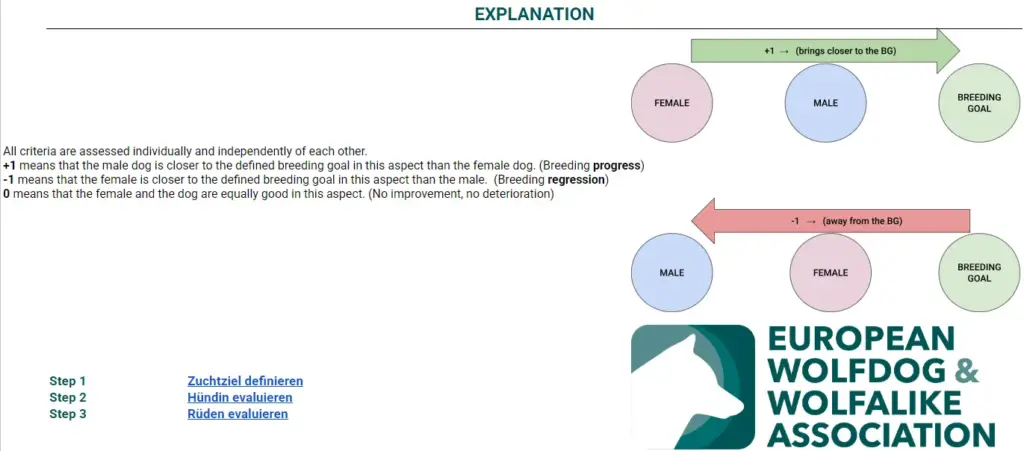
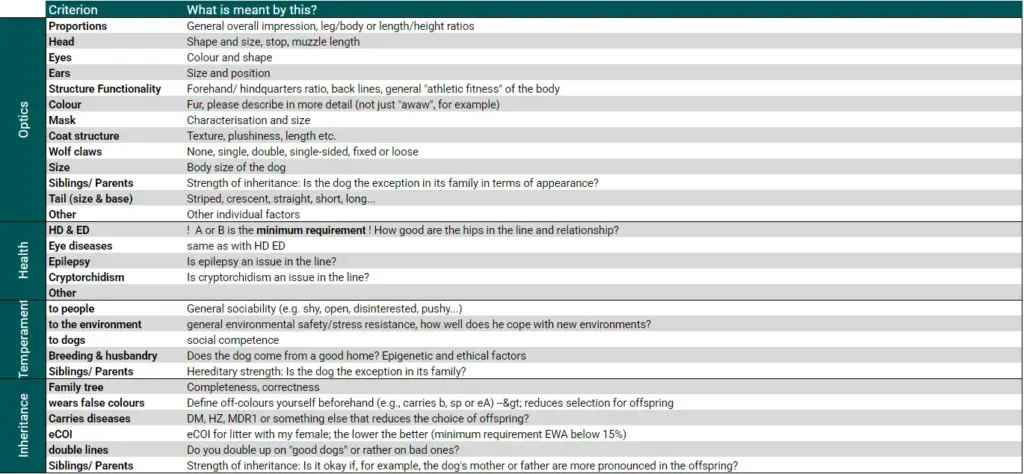
Summarised results
The general summary in the second tab (at the bottom of the page) gives you an overview of all the values of the female and male(s) as soon as you have filled them in. This gives you a direct comparison between all potential partners and a better overview of which of the males would ultimately be the best match (or could be considered for the future). You can leave out this tab at the beginning, as it only becomes relevant once everything else has been entered.
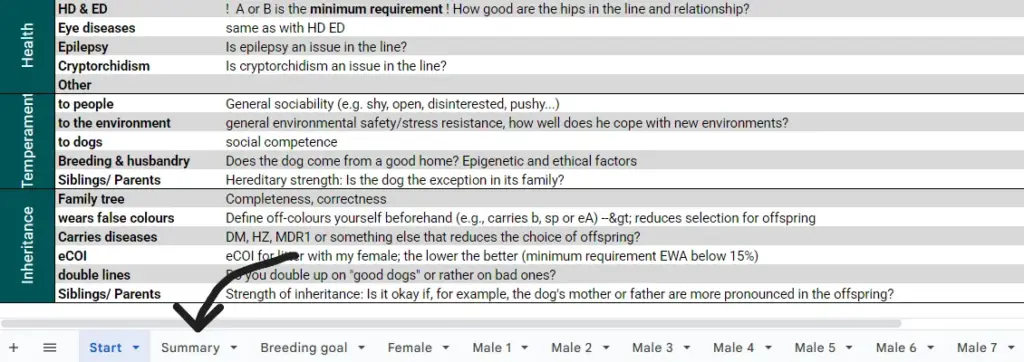
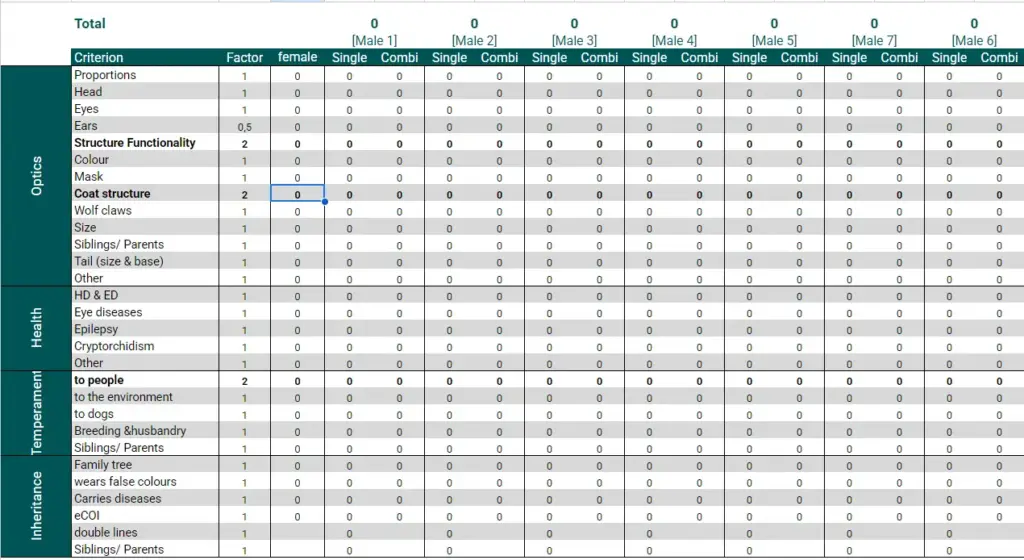
What do all the values mean?
+1 shows that the male brings an improvement compared to the female in relation to the breeding goal (in breeding terms, an advance), -1 would be a characteristic where the female is closer to the breeding goal than the dog (regression in breeding) and 0 indicates that the dog and the bitch are similar in this trait, so there is neither a deterioration nor an improvement in relation to the breeding goal.
For each dog, you will not only see its own value, but also what the result would be if the dog were combined with the respective bitch.
Not all numbers are adopted exactly
Was euch eventuell auch aufgefallen ist sind die Werte von +2 bzw. -2, die oben in der Liste stehen. Hier wurde bei der Hündin selbst der Wert 1 eingetragen (und beim Rüden zum Beispiel -1), aber in der Übersicht hat das Merkmal ‘Fellstruktur’ den Wert 2, also eine höhere Gewichtung für das Gesamtresultat als andere Merkmale.
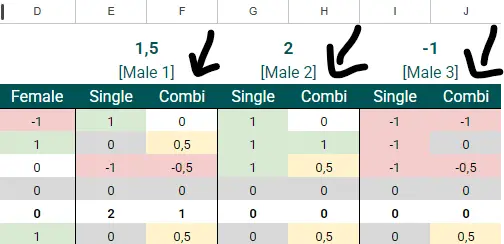
Above each combination, you can also see a separate value (4 – 5.75 – 8.25). This is the combination of the female with each male and the resulting maximum values in the chart for each possible combination. The higher the value, the more points that positively apply to the breeding goal.
The breeding goal
The next tab in the list is the breeding goal. This is the first step to using the male dog chart efficiently. Here you can see all the characteristics that we use as a reference point in breeding. As already listed on the home page, you can now enter everything that is relevant to your individual breeding goal. This involves very specific content, the absolute ideal, as you see it, broken down into individual points.
In addition to the definitions, you can also change the weighting of the individual characteristics here. The values you find here are, so to speak, placeholders and if, for example, you consider ears to be more important or the coat structure to be less important, you simply enter the value that seems more appropriate to you here. This then also appears in the summary as a guideline.
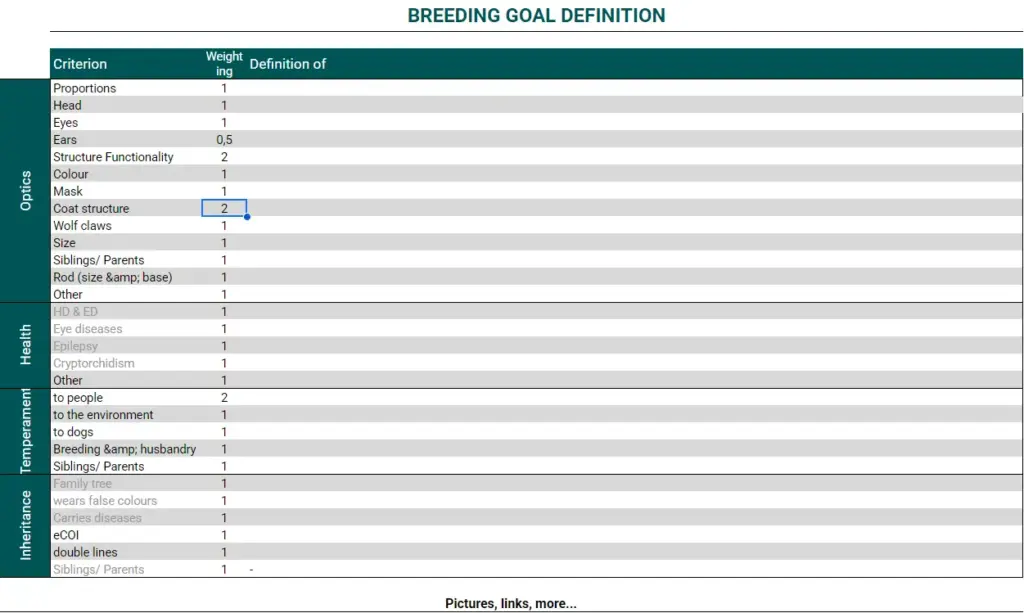
The female
As soon as the breeding goal is set, all points are ticked off and entered, and you are satisfied with the point distribution, you can open the next tab, ‘Bitch’. Here, just as with the breeding goal, each characteristic for your bitch is evaluated individually and, depending on how positive or negative the characteristics are, a value is entered. Our example female has a value of 1 for ‘Proportions’, so she is close to the breeding goal, but a value of -1 for cryptorchidism, because there may be a greater risk here than we would like.
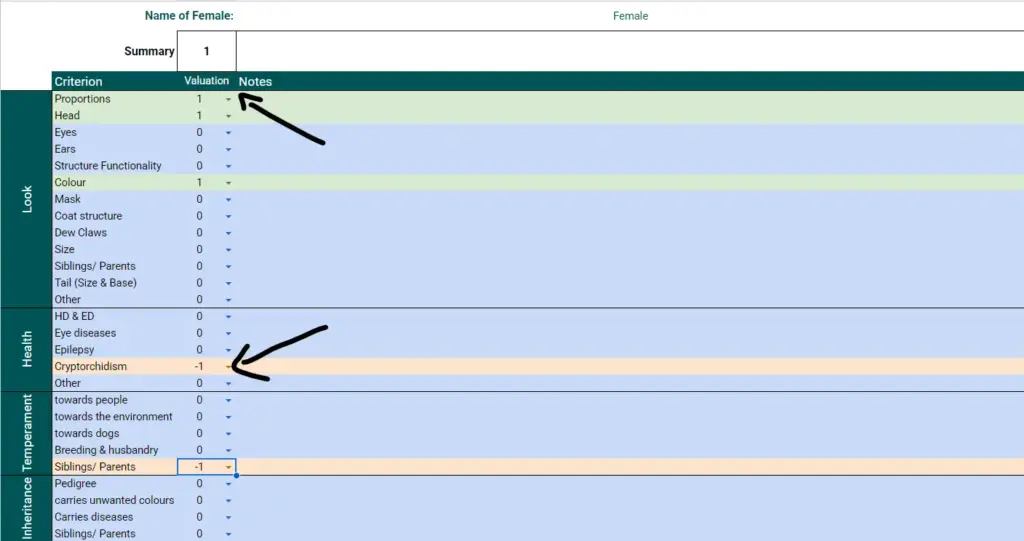
The stud dog/s
Just as with the female, you now go through each male for potential studs. You can change the name in the tab for both female and male 1, male 2, etc. It will then also appear at the bottom of the list and you will immediately know which dog it is. To do this, simply double-click on the name of the tab at the bottom of the page and enter the desired name:
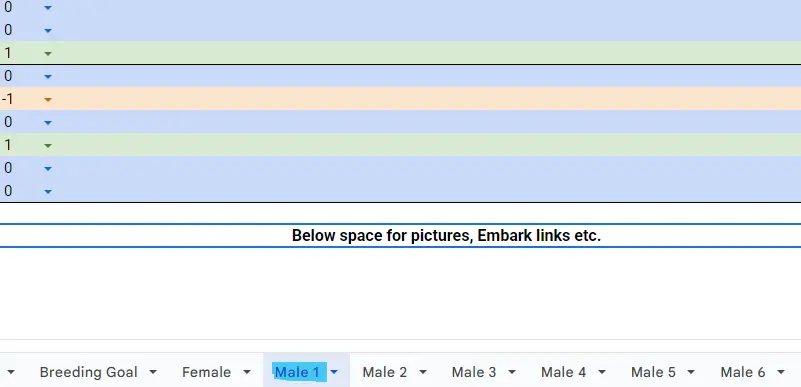
In the chart of male 1, this does not change the name, which you can change here above the evaluation by double-clicking to keep it consistent:
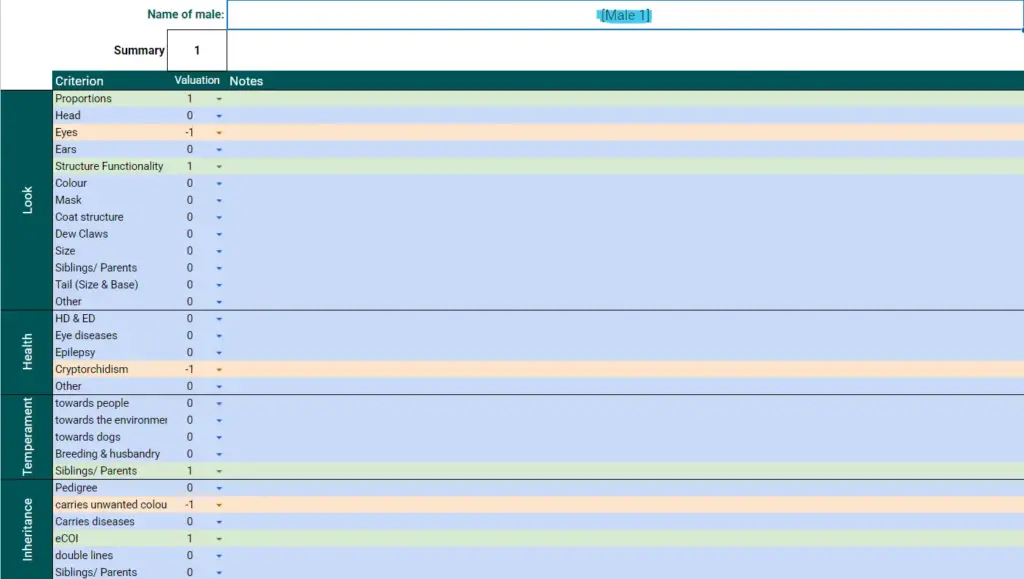
The name in the summary changes automatically when you adjust the name of the male (see above) above the evaluation for that male.

And off you go!
By and large, that’s all you need to know! Although this chart does not replace getting to know each other in person, health tests and compatibility between the dogs (these points are all far more important to clarify in the real world), it does provide a good overview of all the points that can be defined for your breeding goal.
One important note at the end:
A very important point to keep in mind when it comes to the stud dog chart and its use is to take a critical look at all the characteristics and how/why they have been evaluated. Just because one male has more points than another should not be the deciding factor in choosing one over the other. Especially when your gut feeling says ‘actually I like the other one better visually’, you should always ask yourself ‘why actually?’. Perhaps there are still points that you should reconsider in your breeding goal; perhaps you should re-evaluate the weighting because you notice that a dog that visually matches the defined breeding goal does not match what you had in mind, and so on. In any case, it is helpful to have a second (or third or fourth or…) pair of eyes look over it, perhaps to draw attention to weaknesses in the definition or to ask specific, constructive questions about decisions. A few days distance to the document, after you have filled it, is certainly not a mistake either. Often this helps to get a new perspective on your wish list and also to find a more concrete definition for important aspects that are also helpful for communicating with the outside world (what are my values, what are my priorities, what do you get when you buy a puppy from me?). For breeders who follow a breed standard, it can also be helpful to compare their own vision with the standard and adjust it if necessary. Our breeding committee is of course always available to support you with all these points!
I hope I was able to help you a little with this guide. We have designed the document to be very simple so that it can be used quickly. If anything is unclear or you have any further questions, please feel free to contact us at any time, either at zucht@europeanwolfdogsandwolfalikes.com or at fabrizio@wolfdogsandwolfalikes.com.


